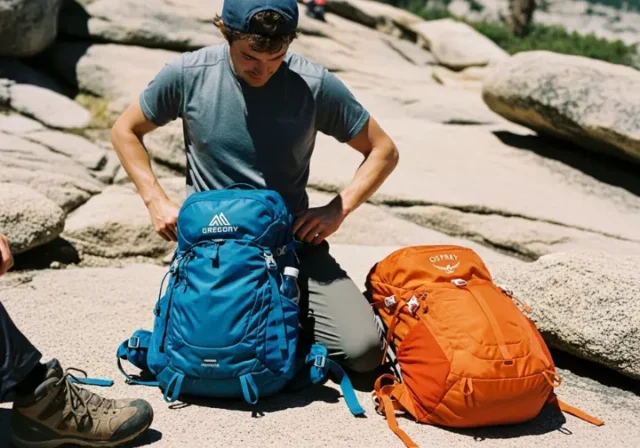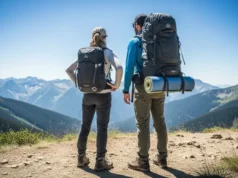In this article
The trail is unforgiving, but your pack shouldn’t be. Choosing between a Gregory backpack and an Osprey isn’t just a gear choice; it’s a decision between two fundamentally different philosophies of comfort. This guide moves beyond the marketing jargon of “AirScape” and “FreeFloat” to give you the load-comfort verdict. We will analyze the real-world load-carrying performance of these technical backpacks, arming you with the knowledge to decide whether you need a flexible partner that moves with you or a secure embrace that feels like a part of you.
This isn’t just another spec sheet comparison. We’re here to help you become an empowered expert, able to diagnose your own comfort needs—whether you need a men’s or women-specific fit—and select the best backpacking backpack for your needs based on its core engineering philosophy, not just brand loyalty. You’ll discover why the engineering difference between Gregory’s “Dynamic Comfort” and Osprey’s “Integrated Suspension” is the most critical factor in your choice. We will teach you the non-negotiable, four-step protocol for achieving a perfect fit that transfers 80% of the load to your hips, where it belongs. We’ve even done the heavy lifting for you, delivering our verdicts for four key hiker types: the Ultralight Thru-Hiker, the All-Around Weekender, the Expedition Heavy-Hauler, and the Agile Day Hiker. And finally, you’ll get the inside track on the 2025 innovations, including how Gregory’s new AirCushion backpanel stacks up against Osprey’s legendary Anti-Gravity suspension.
How to Choose the Right Gregory Backpack: An Expert’s Framework
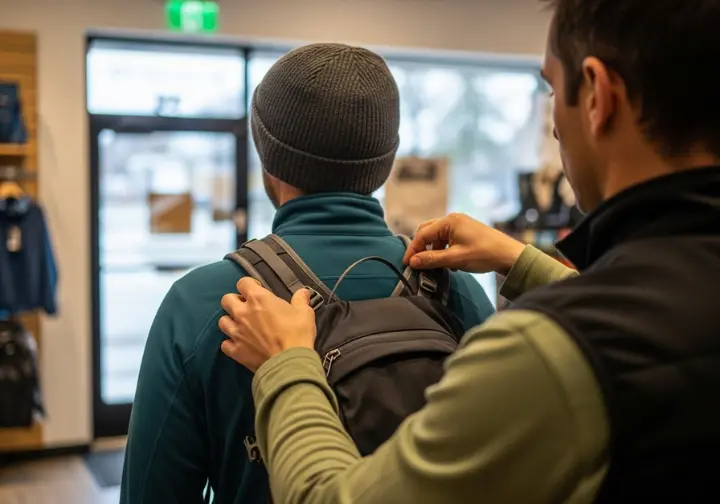
Before we pit brand against brand in the great Gregory vs Osprey debate, you need a framework. The difference between a punishing 10-miler and a glorious one often comes down to understanding a few core principles of biomechanics and pack design. This is the objective knowledge that will empower you to make a smart, confident choice that lasts for a decade of adventures.
Why is Load Transfer More Important Than Total Weight?
Hikers often obsess over shaving grams from their pack’s base weight, but they miss the bigger picture. A 3-pound pack that fits poorly will feel heavier and cause more fatigue than a 4.5-pound pack that fits perfectly. The magic is in load transfer and finding the load sweet spot. The entire goal of a modern internal frame backpacking backpack is to transfer 75-80% of its weight off your fragile shoulders and onto your body’s strongest platform: the skeletal structure of your hips and powerful leg muscles. This is achieved by managing your center of gravity. A well-designed pack allows you to position the heaviest gear—like a full water reservoir, food, and cookware—close to your spine and centered between your shoulder blades. This provides heavy load support and minimizes the sensation of being pulled backward, which saves an incredible amount of energy over the course of a day on multi-day trails.
This is where the great philosophical divide between Gregory and Osprey begins. It’s a question of dynamic versus static stability. Gregory’s design ethos often favors a system that flexes and pivots with your hips and shoulders, a concept of dynamic stability that moves with your natural gait. Osprey, particularly with its AG system, champions a more static stability, creating a locked-in, “hugging” feel that makes the pack an extension of your torso. Understanding which principle you prefer is the first step to choosing your brand.
What are the Core Components that Define a Backpack’s Performance?
Knowing the parts of a rucksack gregory is like knowing the ingredients in a recipe; it helps you understand the final result. A pack’s performance is defined by an integrated network of components and its suspension technology working in harmony. It starts with the frame, which is the pack’s skeleton. Most quality packs use a peripheral frame, typically of aluminum or lightweight steel, that runs along the outside edge of the ventilated back panel. This, along with one or more stays and a framesheet, prevents “barreling”—the awful phenomenon where a poorly packed bag bulges into a barrel shape, pulling away from your back and ruining the load transfer.
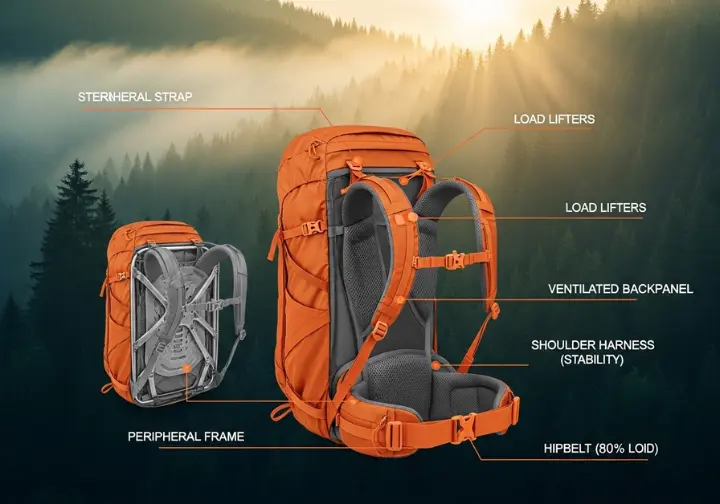
This frame is the anchor for the suspension system—the network of the backpanel, shoulder harness, and hipbelt. These three parts form the “Fit Trinity” that dictates load-carrying comfort. The hipbelt is the workhorse, responsible for bearing that critical 80% of the load. The shoulder straps, which form a plush harness, are not for carrying weight; they are for stability. For a women-specific fit, this will be a curved harness with straps set closer together. The load lifters—those small straps connecting the top of the shoulder straps to the top of the pack—are for fine-tuning. Finally, the sternum strap simply prevents the shoulder straps from splaying outwards. For a deeper look at all the features to consider, you can read our complete guide to backpacking backpacks.
How Do I Find My Perfect Fit? (And Why It’s Not About Your Height)
This is the most critical, non-negotiable step. Your height is almost irrelevant; your torso length is everything. You must measure, not guess. To find your torso length, tilt your head forward and find the most prominent vertebra at the base of your neck—that’s your C7. Then, place your hands on your hips with your thumbs pointing backward; the imaginary line between your thumbs traces your iliac crest. The distance between your C7 vertebra and that line is your torso length. This measurement determines your pack size (S, M, L), a critical first step to a proper fit.
Once you have the right size, follow the in-store fitting protocol religiously, preferably with 15-20 pounds of weight in the pack. First, loosen all the straps. Put the pack on and position the hipbelt so the padded sections are centered over your hip bones, then tighten it snugly. It should be tight enough that it won’t slip down. Many modern packs feature significant hip-belt adjustability to accommodate a wide range of waist sizes, and brands like Gregory are increasingly offering dedicated plus-size pack models with extended-length shoulder straps and hipbelts, ensuring a proper fit for every body type. Second, pull down on the shoulder straps until they are snug. Third, gently pull the load lifters to a 45-degree angle. Finally, clip and tighten the sternum strap. A good fit feels balanced and stable; a poor one creates pressure points or makes you feel off-balance. For more on what to look for, check out our guide on selecting a premium hiking bag.
Pro-Tip: When trying on a pack in a store, don’t just stand there. Walk around the store. Do some deep knee bends. Lean forward and side-to-side. This simulates trail movement and will immediately reveal any uncomfortable pressure points or slippage in the hipbelt that you wouldn’t notice just standing still.
How Do Materials and Denier Ratings Impact Durability?
The numbers and letters on a spec sheet—like 210D or 630D—tell a story about a pack’s resilience. The “D” stands for Denier, a measure of thread thickness. A higher number like durable 630D Nylon, sometimes in a dobby weave, indicates a thicker, more abrasion-resistant thread, which is why you’ll find it on the bottom of packs that get scraped against rocks. A lower number like 100D Nylon Dobby signifies a lighter main fabric used in the body of a lightweight backpack to save weight.
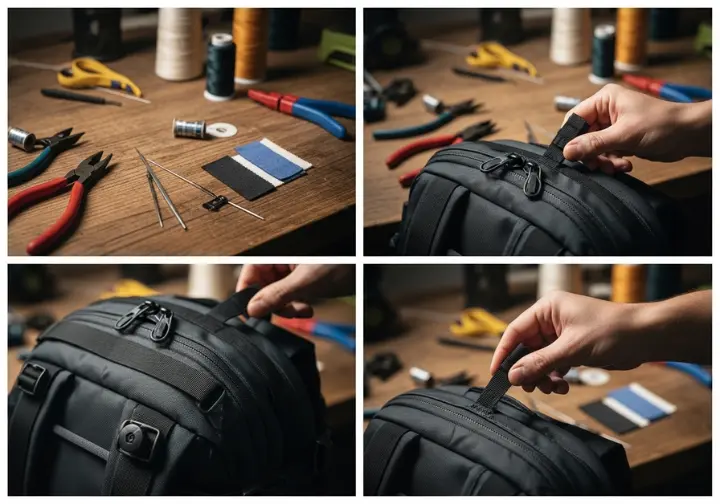
Both Gregory Mountain Products and Osprey are masters of zoned construction, using a patchwork of different denier fabrics to place toughness where it’s needed and lightness where it’s not. This is how they balance durability with weight. In recent years, the sustainability showdown has reached near-parity, with both brands making a significant shift to recycled materials and PFC-free DWR coatings. Investing in a pack with high-quality materials is a key part of selecting the right hiking and camping gear that will last.
Pro-Tip: Durability isn’t just about the fabric. Before buying any pack, run every single zipper back and forth multiple times. They should be smooth and snag-free. Look closely at the stitching, especially where the shoulder straps and hipbelt attach to the pack body. It should be dense, even, and reinforced with bar tacks (a series of tight, overlapping stitches). This is where a pack will fail first.
Our Selection Process: How We Built This Guide
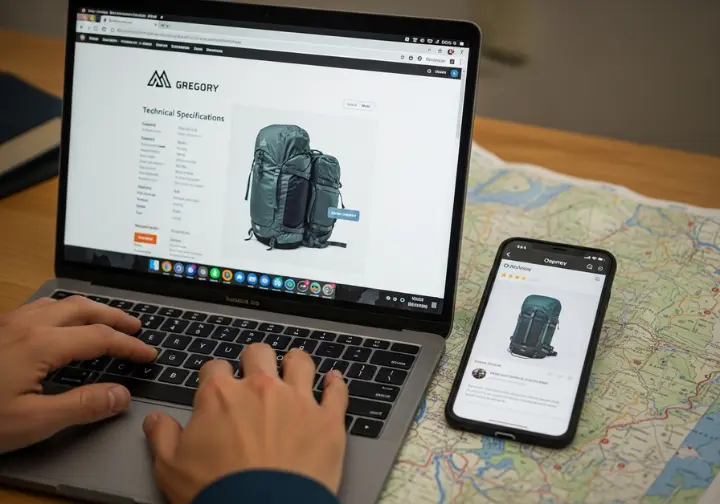
We believe trust is earned through transparency. To build this guide, one of our expert gear guides, we committed to a rigorous and objective process designed to serve one person: you.
- Our Commitment to Objectivity: We aren’t sponsored by Gregory or Osprey. Our only goal is to provide you with the data-driven truth to help you make the best choice for your adventures. Our recommendations are based purely on our analysis and expert consensus.
- The Evaluation Framework: Every pack mentioned was analyzed against the critical attributes discussed above. We didn’t just look at features; we scrutinized load transfer biomechanics, drew up a conceptual load-comfort curve for each model, and studied real-world fit reports.
- How We Selected the Products: Our process was twofold. First, we performed a deep dive into the brands’ complete 2025 engineering schematics and material specifications. Second, we conducted a meta-analysis of dozens of independent expert reviews and verified purchaser reviews to create our on-trail mini case studies and separate marketing claims from on-trail reality.
- A Note on Affiliate Links: If you choose to buy through a link on our site, we may earn a small commission at no extra cost to you. This helps support our independent research and trail-testing. It allows us to keep the lights on but never, ever influences which products we recommend.
The Best Gregory & Osprey Backpacks of 2025: Our Top Recommendations for Every Need
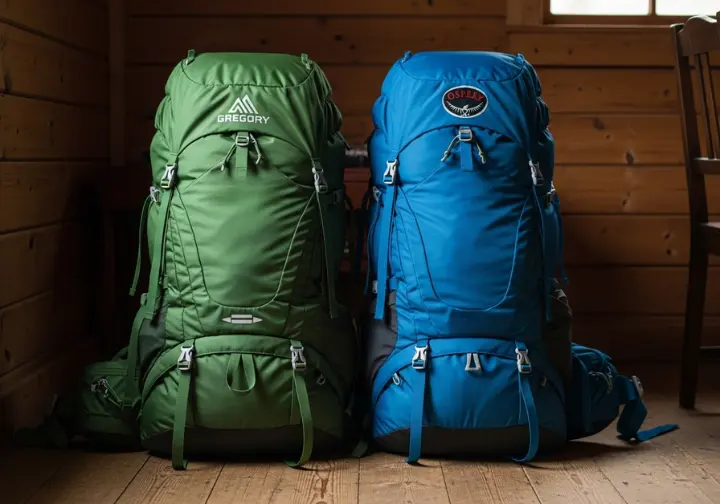
Now, let’s get to the verdicts. We’ve broken down our top picks into four key hiker personas, from the weekend warrior to the expedition pro. Find your profile and discover which model is best for your best use case.
Our Top Picks for the All-Around Weekender
This is the hiker who needs a versatile, reliable workhorse for classic 5-day trips. You’re likely carrying between 30 and 45 pounds and you value a smart balance of comfort, features, and weight without breaking the bank. The women’s-specific Gregory Maven is the direct counterpart to the men’s Paragon, just as the Osprey Aura is to the Atmos 65 AG.
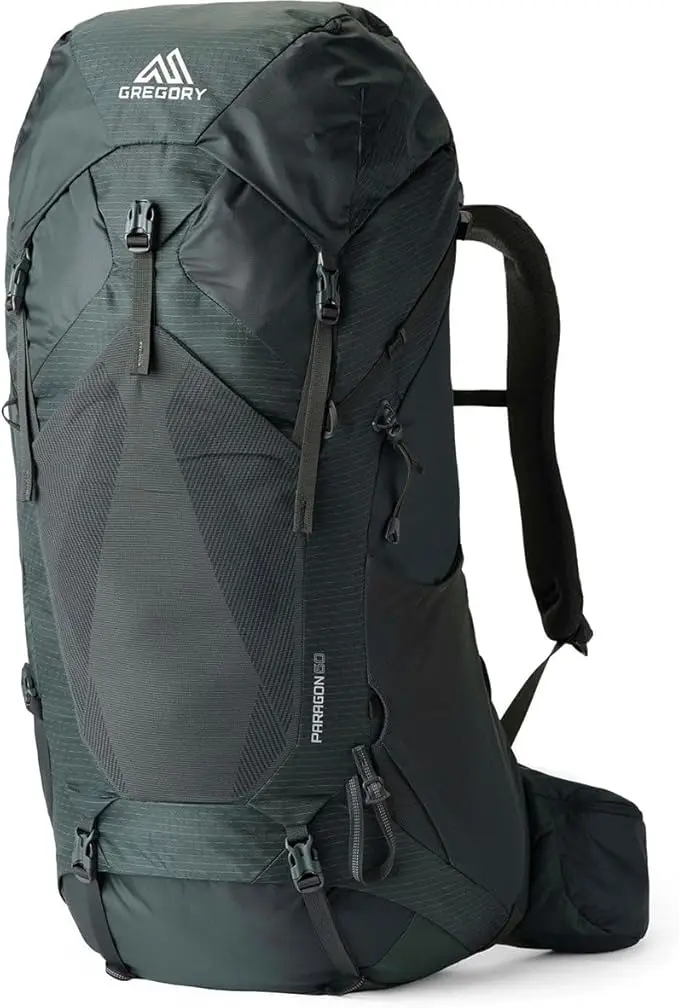
The Gregory Paragon 60 is arguably the smartest choice for the vast majority of hikers. It delivers a premium, dynamic comfort experience by using the FreeFloat suspension system, which allows the hipbelt to flex with you, saving energy on every step. It brilliantly balances weight, features, and value, coming in significantly lighter than its main competitor while including thoughtful touches like a full-length side U-Zip for easy access and a dedicated shoulder strap pocket for your Garmin inReach. This pack solves the problem of over-buying an expensive, heavy pack by giving you 95% of the high-end features at a lower weight and cost.
PROS
- Dynamic FreeFloat comfort
- Lighter than its competitor
- Excellent value for features
CONS
- Front mesh durability concerns
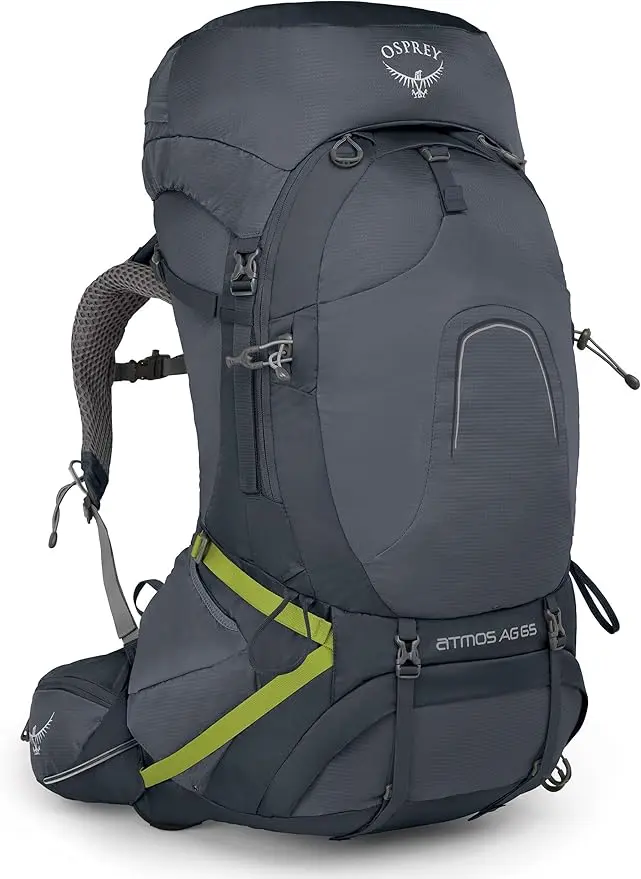
The Osprey Atmos AG 65 remains the undisputed king of ventilation and feature-rich design. Its legendary Anti-Gravity (AG) suspension creates a seamless mesh backpanel that wraps you in a comforting “hug” while providing unmatched airflow. For hikers who run hot or can’t stand a sweaty back, this pack is the ultimate solution. It’s loaded with smart features like a removable lid, dual side zippers for access, and the Fit-on-the-Fly™ hipbelt for on-trail adjustments. The trade-off for this level of ventilated comfort and organization is that it’s one of the heaviest and most expensive packs in its class.
PROS
- Unmatched ventilation
- Hugging anti-gravity comfort
CONS
- Heavier and more expensive
- Can feel bulky
Our Top Picks for the Expedition Heavy-Hauler
You are the hiker carrying serious weight—over 40 or 50 pounds—for long-distance treks, winter camping, or hauling professional gear like photography equipment in the wilderness. For you, stability and load management are not just features; they are survival tools. Here, the Gregory Deva is the women’s version of the Baltoro 65, and the Osprey Ariel 65 is the counterpart to the Aether.
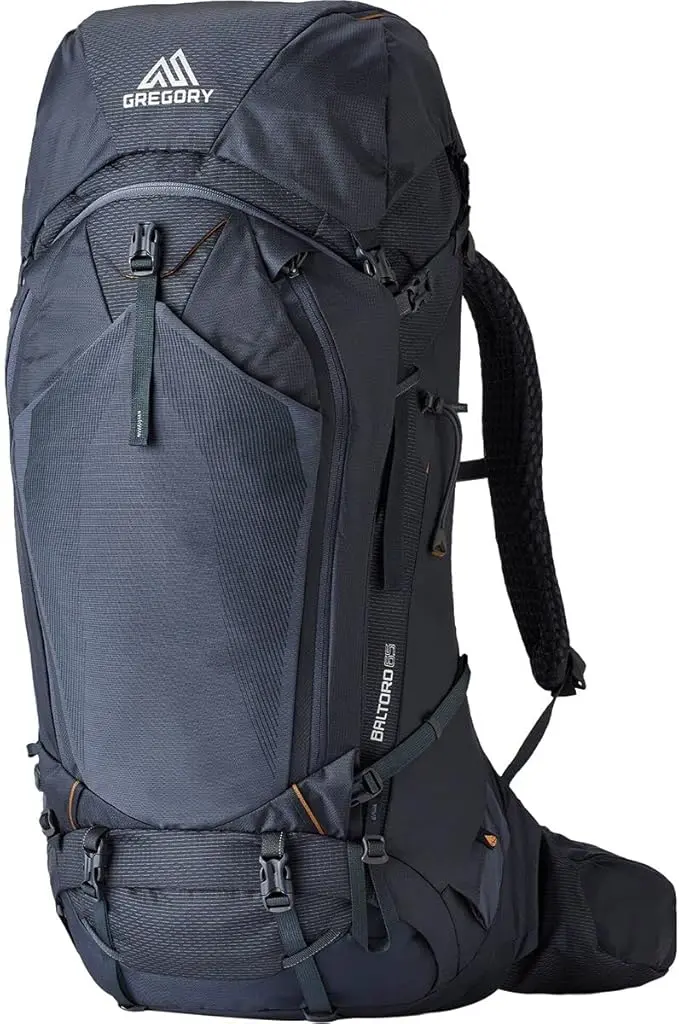
The Gregory Baltoro 65 is the premier choice for dynamic comfort when managing massive loads. Its advanced FreeFloat A3 suspension system allows the harness and hipbelt to pivot and rotate independently, working with your body’s natural motion to reduce fatigue. For 2025, it features a new, highly breathable AirCushion backpanel that offers best-in-class cooling at the point of contact. Built around a robust alloy steel and fiberglass frame, it manages loads of 50+ pounds with ease. For the hiker who values a flexible carry that prevents the rigid, restrictive feeling common with heavy packs, the Baltoro is the answer.
PROS
- Dynamic carry for heavy loads
- Excellent breathability
CONS
- Flexible feel isn’t for everyone
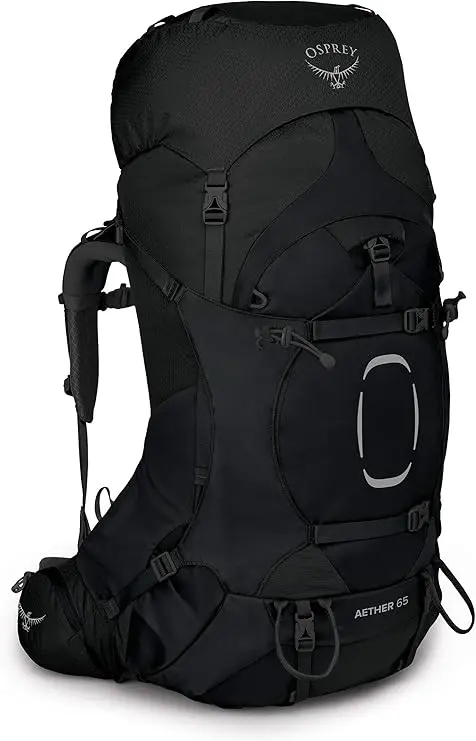
The Osprey Aether 65 is an unyieldingly stable fortress of a pack, built to inspire absolute confidence on treacherous terrain. Its design philosophy prioritizes a close-to-body, secure feel, using an AirScape backpanel and famously robust 420HD nylon to create a rock-solid platform. The Aether’s calling card is its extreme customization, featuring the Fit-on-the-Fly™ adjustment system and even the option for a custom-molding hip belt in some retail locations. This is the perfect solution for the hiker who wants their heavy pack to feel absolutely locked to their body with zero sway or movement.
PROS
- Rock-solid stability
- Highly customizable fit
CONS
- Less ventilation than Baltoro
- Heavier overall build
Our Top Picks for the Agile Day Hiker
You’re tackling demanding day hiking trips with 15-25 pound loads, and you need a daypack that provides mobility and support without feeling cumbersome. Whether you’re scrambling up a peak or logging a fast-and-light 15-miler, you need one of these day-hike packs. The women’s Osprey Tempest 20 mirrors the Talon, while the Gregory Juno 24 mirrors the Zulu 30. For cyclists, a pack with a dedicated mountain-bike fit like the Endo 15 or Osprey Syncro 12 is ideal.
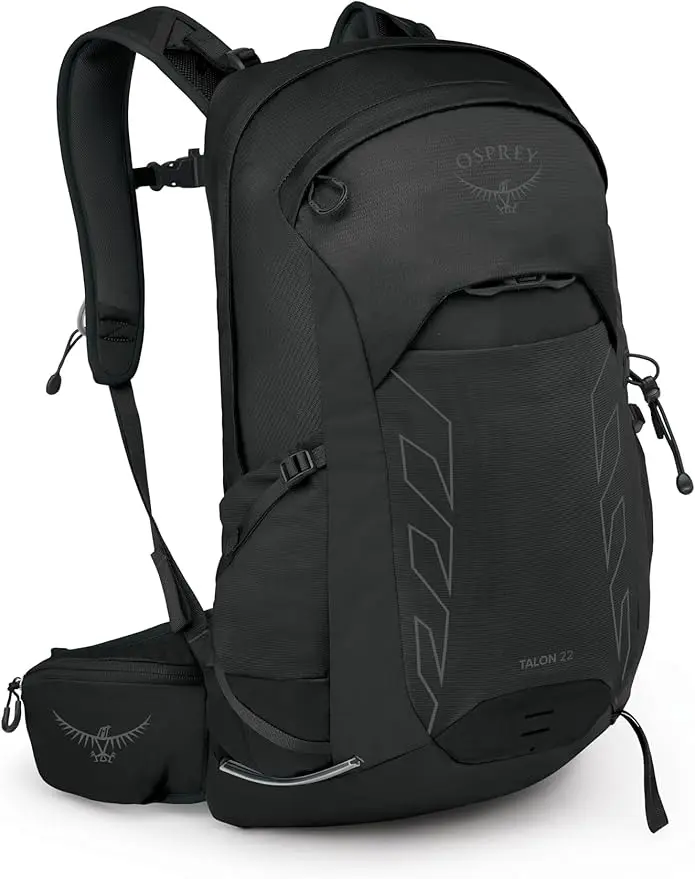
The Osprey Talon 22 is the long-standing benchmark for multi-sport versatility. It excels during fast-paced activities by providing a secure, body-hugging fit that feels like an extension of you, never throwing you off balance during dynamic movements. The updated AirScape backpanel offers a close, stable carry with improved breathability, and its famous wrap-around feel is perfect for scrambling. With versatile features like the LidLock helmet attachment and trekking pole loops, it’s the ideal “quiver of one” for hikers who also bike and climb.
PROS
- Body-hugging fit for speed
- Great multi-sport versatility
CONS
- Heavier than minimalist daypacks
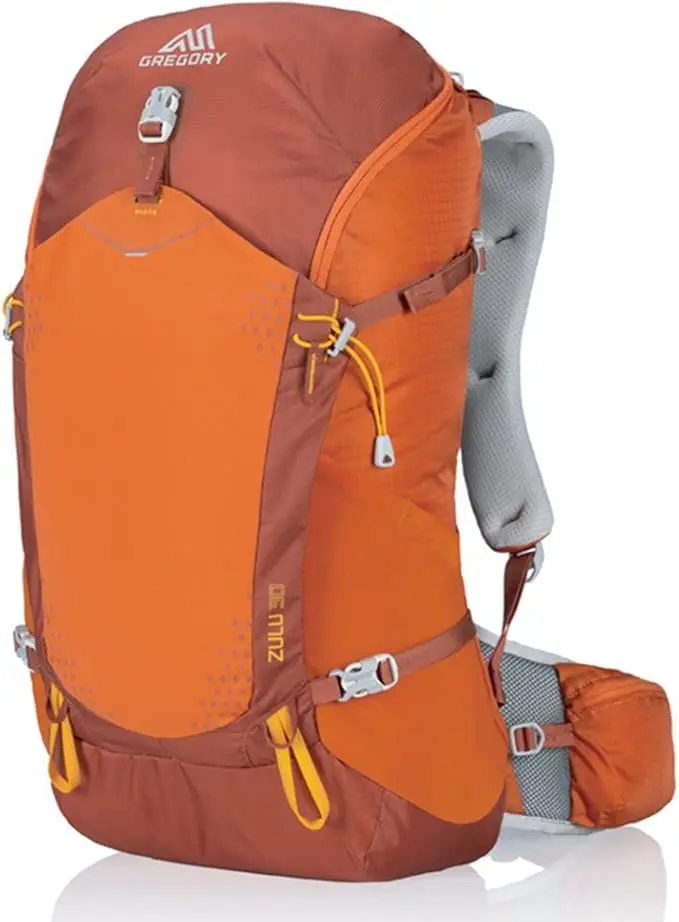
The Gregory Zulu 30 is best described as a “backpacking pack scaled down.” It offers a level of suspension and load-carrying comfort that surpasses nearly all other daypacks on the market. It uses Gregory’s FreeFloat ventilated suspension and a plush, substantial hipbelt to provide exceptional comfort with heavier day loads. Its 30L volume is perfect for winter hiking with extra layers or for the “heavy packer” who always brings extra gear, including a hydration pack in the dedicated reservoir sleeve. For the day hiker who treats their outings like “light backpacking” and needs robust support for loads cresting 20 pounds, the Zulu is the ideal choice.
PROS
- Superior backpacking suspension
- Excellent for heavier day loads
CONS
- Can be overkill for simple hikes
Our Top Picks for the Ultralight Thru-Hiker
You are a minimalist focused on efficiency over multi-month treks, a classic ultralight thru-hiking scenario. Every gram counts, and you need a pack that can comfortably manage a dialed-in load of 25-35 pounds for thousands of miles. Adaptability and on-trail quality of life are paramount for any successful thru-hiking adventure, like a traverse of the Tetons. Here, the women-specific Osprey Eja and Gregory Facet are the counterparts to the men’s Exos 58 and Focal 58.
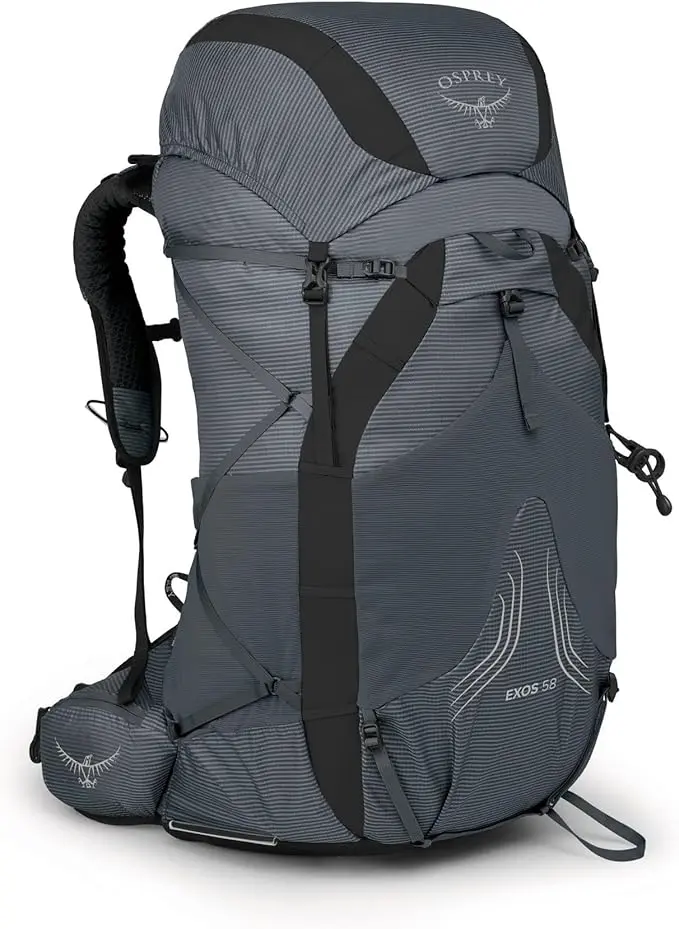
The Osprey Exos 58 is the safest and most adaptable choice for the long haul. Its legendary AirSpeed suspended mesh backpanel provides maximum airflow, a godsend on hot, exposed trail sections. Crucially, it features an adjustable torso length—a critical feature for adapting to a hiker’s changing body as they slim down over a months-long thru-hike. The latest version reintroduced highly requested hipbelt pockets, solving a major complaint from previous models. The Exos solves the long-term comfort problem by allowing you to fine-tune the fit as your body changes.
PROS
- Best-in-class ventilation
- Adjustable fit for thru-hikes
CONS
- Not ideal for very heavy loads
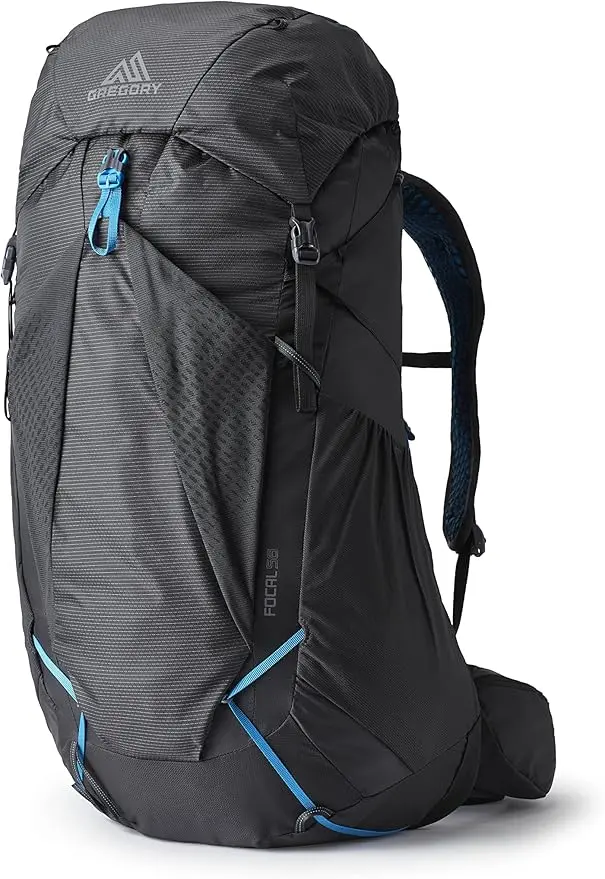
The Gregory Focal 58 is the lighter-weight, feature-superior option for the dialed-in ultralight hiker who prioritizes on-the-go access and a more stable-feeling carry. It is consistently lighter than the Exos and is widely praised for its enormous, easily accessible hip-belt pockets—solving the critical on-trail “snackcessibility” problem. Its version of the FreeFloat suspension keeps the pack’s center of gravity closer to your back, providing a more stable feel that some hikers prefer. Its design DNA can be traced back to previous frameless-style models like the popular Gregory Optic 55. The major trade-off is that its torso length is fixed, which can be a risk for goal-oriented thru-hikers whose bodies change significantly.
PROS
- Lighter than the competitor
- Best-in-class hipbelt pockets
CONS
- Fixed, non-adjustable torso
Conclusion
The final verdict between Gregory and Osprey isn’t about a winner and a loser; it’s about aligning your personal hiking style with a specific engineering philosophy. The choice is a choice of feel: Gregory’s dynamic flex creates a pack that moves with you, conserving energy through a natural gait, while Osprey’s secure hug creates a pack that feels like part of you, inspiring confidence with unshakeable stability.
Remember that true load comfort is achieved through proper load transfer, not just plush padding. Nailing the perfect fit to put 80% of the weight on your hips is the most important factor in your decision. For 2025, the ventilation arms race is clearer than ever, defined by the choice between Osprey’s ventilated air gap (Anti-Gravity/AirSpeed) and Gregory’s innovative breathable contact padding (AirCushion). The “best” pack is ultimately relative to your needs. For most people, the Gregory Paragon/Maven offers the best all-around value, while for thru-hikers, the adaptability of the Osprey Exos/Eja provides critical long-term security.
Now that you’re armed with the expert framework, which comfort philosophy aligns with your hiking style? Share your choice or ask a question in the comments below—let’s help the community make a better decision.
Frequently Asked Questions about Gregory and Osprey Backpacks
Is Gregory or Osprey better for heavy loads (over 40 lbs)?
Both brands make exceptional heavy-haulers, but they offer two very different comfort experiences. The Gregory Baltoro/Deva uses a dynamic suspension that pivots and flexes with your body, which many users find reduces fatigue over long days because the pack moves with their natural gait. The Osprey Aether/Ariel provides a more rigid, locked-in stability that makes the pack feel like a single, solid unit with your torso. If you prefer a pack that moves with you and feels more agile, choose the Gregory Baltoro. If you prioritize rock-solid stability and a completely secure feel, choose the Osprey Aether.
Which backpack brand is better for ventilation and preventing a sweaty back?
Historically, Osprey has been the undisputed industry leader in ventilation. Their Anti-Gravity (AG) and AirSpeed suspension systems create a large gap between your back and the pack itself, allowing for maximum airflow. For hikers who prioritize a cool back above all else, the Osprey Atmos AG or Exos are still top choices. However, Gregory’s new AirCushion backpanel is a powerful competitor. Instead of creating a gap, it uses a 3D, foamless mesh that provides incredible breathability right at the point of contact, eliminating the feeling that the pack is pushed away from your back.
Is the Gregory Paragon or Osprey Atmos a better all-around backpacking pack?
While both are excellent packs, the Gregory Paragon is the better overall choice for the majority of hikers. It provides an exceptional balance of dynamic comfort, useful features, and a significantly lighter weight, all at a more accessible price tier. The Osprey Atmos is an outstanding pack, but its higher weight and cost are only justified if you absolutely must have the maximum possible ventilation and its specific feature set. For most weekend and multi-day trips, the Paragon delivers a more practical and valuable package.
Do I really need to get fitted in a store?
Yes, absolutely. A proper fitting is the single most important step you can take to ensure comfort on the trail and prevent potential soreness or injury. Measuring your torso length is non-negotiable, as it dictates your pack size (S, M, L) and is often different from what you might guess based on your height. Furthermore, trying a pack on with 15-25 lbs of weight inside is the only way to truly feel how its unique suspension system will interact with your body shape and how the load will transfer to your hips.
Risk Disclaimer: Hiking, trekking, backpacking, and all related outdoor activities involve inherent risks which may result in serious injury, illness, or death. The information provided on The Hiking Tribe is for educational and informational purposes only. While we strive for accuracy, information on trails, gear, techniques, and safety is not a substitute for your own best judgment and thorough preparation. Trail conditions, weather, and other environmental factors change rapidly and may differ from what is described on this site. Always check with official sources like park services for the most current alerts and conditions. Never undertake a hike beyond your abilities and always be prepared for the unexpected. By using this website, you agree that you are solely responsible for your own safety. Any reliance you place on our content is strictly at your own risk, and you assume all liability for your actions and decisions in the outdoors. The Hiking Tribe and its authors will not be held liable for any injury, damage, or loss sustained in connection with the use of the information herein.
Affiliate Disclosure: We are a participant in the Amazon Services LLC Associates Program, an affiliate advertising program designed to provide a means for us to earn advertising fees by advertising and linking to Amazon.com. As an Amazon Associate, we earn from qualifying purchases. We also participate in other affiliate programs and may receive a commission on products purchased through our links, at no extra cost to you. Additional terms are found in the terms of service.



